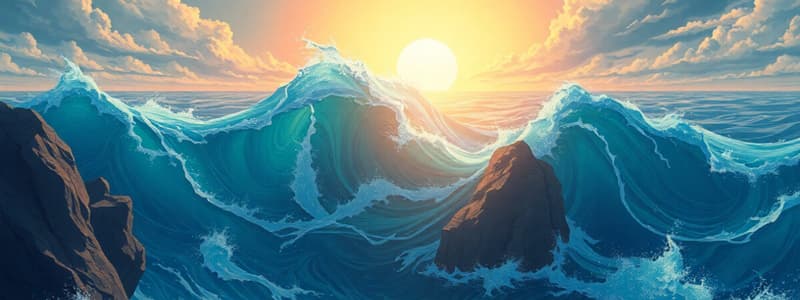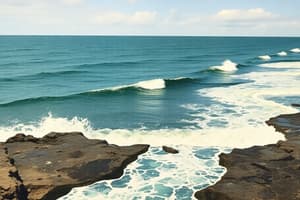Podcast
Questions and Answers
What primary factor does the equilibrium theory of tides disregard?
What primary factor does the equilibrium theory of tides disregard?
- Gravitational forces between the Earth, moon, and sun
- The influence of ocean depth (correct)
- The orbital paths of the Earth and moon
- The concept of tidal potential
Which of the following is a key consideration in the dynamic theory of tides but not in the equilibrium theory?
Which of the following is a key consideration in the dynamic theory of tides but not in the equilibrium theory?
- The balance of forces maintaining Earth's orbit
- The gravitational pull of the moon
- The speed of tidal waves in shallow water (correct)
- The gravitational pull of the sun
The equilibrium theory is most accurate under what hypothetical condition?
The equilibrium theory is most accurate under what hypothetical condition?
- In deep ocean basins far from landmasses
- On a theoretical planet uniformly covered by water (correct)
- During periods of strong solar activity
- When considering coastal regions with complex topography
What is the origin of tidal potential, according to the theories discussed?
What is the origin of tidal potential, according to the theories discussed?
Regarding the assumptions of the equilibrium theory, which statement aligns with its presumed conditions?
Regarding the assumptions of the equilibrium theory, which statement aligns with its presumed conditions?
Flashcards
Equilibrium Theory
Equilibrium Theory
Describes tides based on the position and gravitational attraction of the Earth, moon, and sun, ignoring ocean depth and landmasses.
Dynamic Theory
Dynamic Theory
Considers factors like shallow water, continents, and water movement to explain tidal patterns more accurately than equilibrium theory.
Tidal Potential
Tidal Potential
The gravitational force from the moon and sun that influences the rise and fall of tides.
Assumptions of Equilibrium Theory
Assumptions of Equilibrium Theory
Signup and view all the flashcards
Gravity's Role in Tides
Gravity's Role in Tides
Signup and view all the flashcards
Study Notes
Equilibrium Theory
- Primarily focuses on the Earth, Moon, and Sun's positions and gravitational forces.
- Ignores ocean depth and continental landmasses' influence.
- Accurately predicts tides on a completely water-covered planet.
- Assumes a flat, uniform ocean surface constantly in equilibrium with gravitational pulls.
- Simplified model of tides, overlooking the complexities of real-world oceans.
Dynamic Theory
- Considers factors like the tide wave's speed in shallow water.
- Acknowledges the effects of continents and water movement in basins.
- Takes into account the circular or rocking motion of ocean water.
- Derives tidal potential from the moon and sun's gravitational pull.
- Aims to provide a more realistic representation of ocean tides.
- Explains tides in terms of gravitational forces and ocean dynamics.
Studying That Suits You
Use AI to generate personalized quizzes and flashcards to suit your learning preferences.




